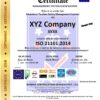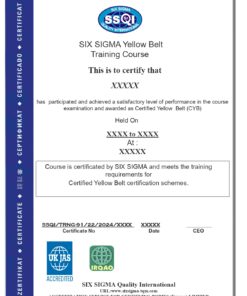Sale!
IMS 9001/14001/18001 Integrated Management
Original price was: ₹20,000.00.₹14,990.00Current price is: ₹14,990.00.
Integrated Management Systems (IMS) refers to the combination of multiple management systems into one unified system that meets the requirements of various international standards. The most commonly integrated standards are ISO 9001 (Quality Management), ISO 14001 (Environmental Management), and ISO 45001 (formerly known as OHSAS 18001 – Occupational Health and Safety Management). Here’s a breakdown of each and how they can be integrated:
1. **ISO 9001: Quality Management System (QMS)**
– Focuses on ensuring that an organization consistently meets customer requirements and enhances customer satisfaction.
– Key principles include customer focus, leadership, process approach, and continuous improvement.
2. **ISO 14001: Environmental Management System (EMS)**
– Focuses on managing an organization’s environmental responsibilities and impacts.
– Key aspects include identifying and controlling the environmental aspects, complying with applicable laws and regulations, and continually improving the EMS.
3. **ISO 45001: Occupational Health and Safety Management System (OHSMS)**
– Focuses on ensuring a safe and healthy working environment by preventing work-related injuries and ill-health.
– Key principles include hazard identification, risk assessment and control, legal compliance, and continual improvement.
**Integration of IMS:**
**Benefits:**
– Streamlined processes and reduced duplication of efforts.
– Improved communication and collaboration among different departments.
– Cost savings by reducing the number of audits, trainings, and documentation.
**Steps for Integration:**
1. **Gap Analysis:** Identify the gaps and overlaps between the different management systems to understand the areas of integration.
2. **Policy Integration:** Develop an integrated policy that addresses the requirements of all standards. This policy should be aligned with the organization’s objectives and context.
3. **Integrated Objectives:** Set integrated objectives that align with the organization’s goals and address quality, environmental, and health & safety aspects.
4. **Documented Information:** Develop integrated documentation, including manuals, procedures, and records that cover the requirements of all standards.
5. **Training and Awareness:** Ensure that employees are trained and aware of the integrated management system, its benefits, and their roles and responsibilities.
6. **Internal Audits:** Conduct internal audits to verify the effectiveness of the integrated management system and identify areas for improvement.
7. **Management Review:** Conduct regular management reviews to evaluate the performance of the integrated management system and make necessary adjustments.
8. **Continuous Improvement:** Implement a continuous improvement process to continually enhance the performance of the integrated management system.
Remember, the key to successful integration is to focus on the commonalities between the standards and to ensure that the integrated system is tailored to the organization’s specific context, needs, and objectives. It’s also essential to engage employees at all levels and to promote a culture of continuous improvement and collaboration.












Reviews
There are no reviews yet.